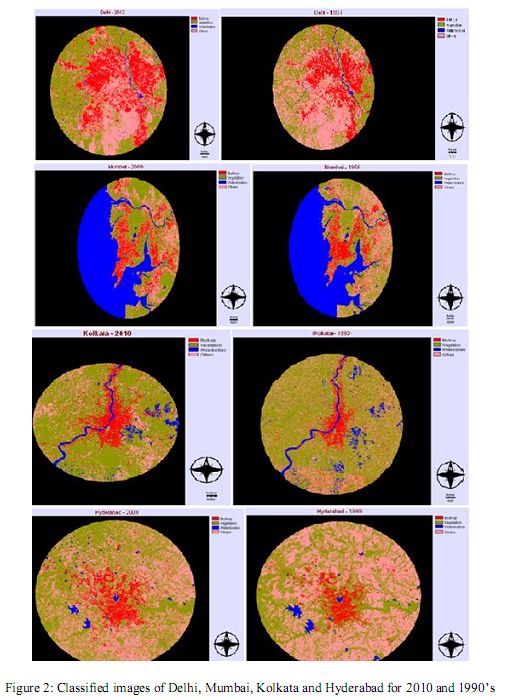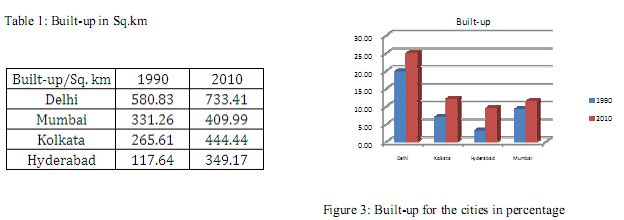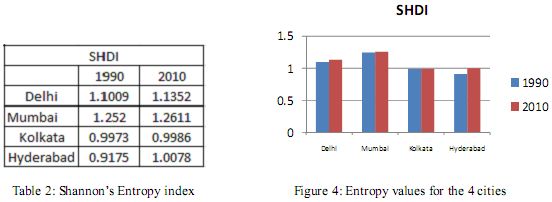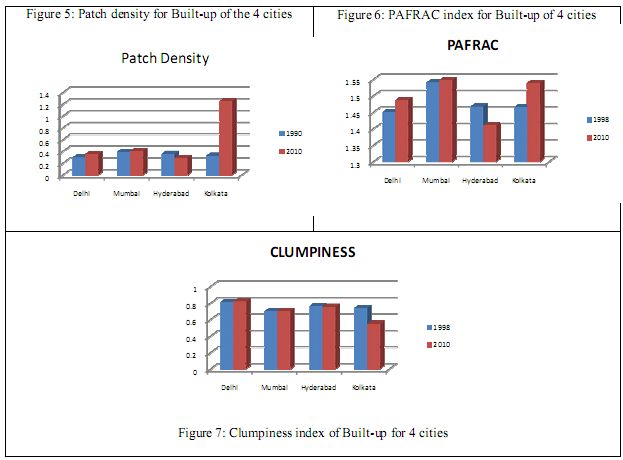Results and Discussions The process of urban land-cover change is most commonly described as either a change in absolute area of urban space (a measure of extent) or the pace at which nonurban land is converted to urban uses (a measure of rate) (Seto et al. 2005). This study shows that the growth rate of Hyderabad for the 20 years time period has increased almost 3 times its area from 1990, whereas for Kolkata the size has increased twice, Delhi and Mumbai has followed the same pattern with increase of about around 100 sq. kms.
1. Landscape metrics The entropy values for Delhi and Hyderabad cities are showing increase in entropy indicating dispersed growth (Table 2, Figure 4) in the region during the period, whereas in Mumbai and Kolkata there is a small marginal increase in both the years showing no change in its built-up growth.
There is slight increase in the patch density (Figure 5) for Delhi and Mumbai, in case of Hyderabad the trend is decreasing indicating dense urban growth, while for Kolkata the patch density has increased greatly for the time period indicating dispersed patches of urban growth in outskirts of the city as well as in the city centers in a ring-shaped manner. While in case of Hyderabad city the patch density is decreased indicating re-densification of urban patches in the region.The PD of Delhi and Mumbai stays constantly at a low level highlighting a laminar coalescence and a laminar urban footprint. The PAFRAC value for Delhi and Kolkata city is increasing from 1990’s to 2010 indicating the urban patches are becoming more irregular/convoluted in its shape, Mumbai city is retaining the complexity of its urban patches with no much changes in its PAFRAC values. While Hyderabad is differing from the above cities with decreasing PAFRAC values indicating that, with re-densification the urban patches are becoming more regular in its shape. Clumpiness index for Delhi, Mumbai and Hyderabad cities have not changed greatly indicating almost the urban patches are disaggregated, as for Kolkata the patches are increasingly disaggregated, from 1990’s to 2010.
Citation : Priyadarshini J. Shetty, Shashikala. V and T. V. Ramachandra, 2010, Urban footprint dynamics in Indian metropolis. Proceedings of the Conference on Infrastructure, Sustainable Transportation and Urban Planning CiSTUP@CiSTUP 2010. 18th - 20th October 2010, CiSTUP, IISc, Bangalore.
|
|||||||||||||||||





